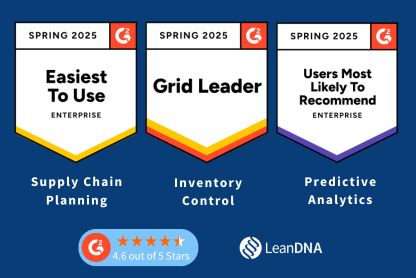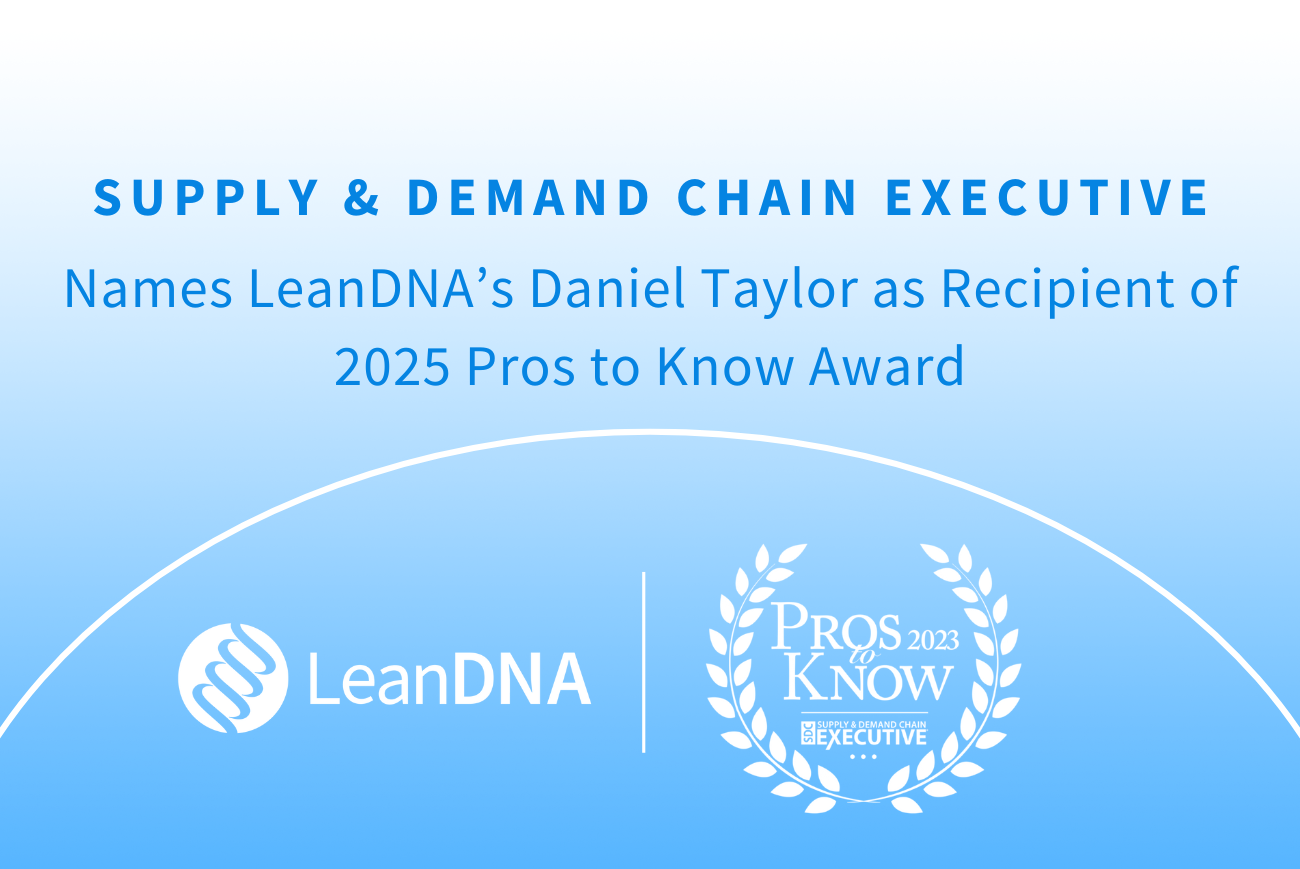Do you need to digitally transform your supply chain data but don't know where to start?
With the amount of data manufacturers juggles, it's no wonder so many face the same dilemma: missing and inaccurate data… on a massive scale! Large, complex set of data can be overwhelming, but it’s time to take action, with the right supply chain data analytics solution improving data health can be easy!
LeanDNA’s built-in data cleansing process helps manufacturers evaluate and fix their data. Over our time working with manufacturers, we’ve discovered 13 common data points where bad data runs rampant. Here’s what you should understand and check if undertaking data cleansing in your own system.
Where to Start for Your Data Cleansing Process
If you are going to cleanse the data yourself, here is a checklist of data to start with to identify duplicates and errors. By checking your supply chain data in segments, you can pinpoint the inaccuracies in your data sets.
Supplier Lead Time

Definition: The number of days it takes to receive inventory after initiating a procurement action, such as firming a PO with a supplier.
Why it's important: Lead times drive ordering and procurement policies. Ordering based on inaccurate data can lead to excess inventory, shortages, and additional headaches which can deeply impact your bottom line.
Common data errors: Two issues commonly cause lead time data to go bad: either the data goes out of date or there’s a difference between promised and actual lead times. It’s more accurate to set lead times with your own lead time data than from dates provided by your supplier.
Demand - Past-Due Requirement
Definition: Open demand that is past its due date and needs to be fulfilled.
Why it's important: Manufacturers occasionally fall behind production schedules, but they still want to adhere to commit dates to avoid disappointing customers. These past-due requirements can drive unnecessary purchases to accommodate unfulfilled demand.
Common data errors: Past-due requirements often stem from SIOP or process problems that happen when work orders and sales orders are not updated simultaneously. For example, we helped one client discover millions of dollars in past-due requirements. LeanDNA unearthed the scope of the problem so the client could quickly improve.
Demand - Missing/Inaccurate
Definition: Demand, typically calculated by MRP, drives manufacturing and purchasing decisions (POs, order policies, replenishment levels, etc.).
Why it's important: Demand is the basis of calculation for procurement policies, replenishment, ROP, etc. If data is missing or inaccurate, your procurement will not go very smoothly!
Common data errors: We typically see missing/inaccurate demand due to inaccurate/outdated bill of materials (BOM), or because forecasting has not been loaded into the system.
Order Policies - ROP
Definition: The designated level of on-hand inventory which triggers an action to replenish that particular inventory.
Why it's important: Failing to resize your ROP based on demand and variability will result in excess inventory or critical shortages.
Common data errors: Data errors occur within ROP when data is not updated to match changing orders and demand. We recommend that you calculate standard deviations of variability in lead time and demand, which can be auto-generated on a daily basis using tools like LeanDNA.
Order Policies - MinMax Level
Definition: A method of controlling inventory by setting a minimum and maximum stock level where a trigger for a replenishment action falls somewhere in the middle.
Why it's important: Failing to optimize order policies can lead to the accumulation of excess inventory or critical shortages
Common data errors: MinMax levels can become incorrect or outdated. This part of your order policy depends upon many moving parts, so make sure you have processes in place to update these numbers regularly.
Order Policies - Order Interval
Definition: A fixed range of time covered by a single order. Increasing order intervals raises the amount of on-hand inventory per order, but reduces the number of transactions. Decreasing intervals increases the frequency of transactions for smaller item quantities.
Why it's important: Order intervals are one of the most common order policies, so it’s likely that a substantial amount of your inventory is managed this way. If you have it wrong, you’re going to end up with excess inventory or excess transactional costs.
Common data errors: Changing manufacturing practices and demand leads to incorrect ABC classification.
Order Policies - Kanban Bin Sizing
Definition: A fixed amount of inventory maintained at a workstation that is replenished upon consumption.
Why it's important: Failing to size your Kanban bins properly can result in excess inventory or shortages. This can be particularly impactful if it occurs at a bottleneck station, which can cause critical disruptions to manufacturing.
Common data errors: Kanban bin sizes can become outdated as order policies change. Demand changes, obsolete inventory, and more can contribute.
MOQ
Definition: Minimum Order Quantity (MOQ) specifies the lowest quantity of a product that a supplier will sell per order.
Why it's important: Inaccurate MOQs drive bad purchasing outcomes and system behavior. MOQ is used to calculate several procurement parameters. Order policies should never suggest quantities below the MOQ.
Common data errors: Just like lead times, MOQs require frequent updates, so errors are likely an issue of outdated master data. Get the most up-to-date MOQs from your suppliers.
Standard Cost
Definition: From a purchasing standpoint, it’s the standard price (what you should pay) for each individual part.
Why it's important: Standard costs are typically set by your finance departments and help control costs as your purchasing team negotiates contracts with suppliers. The most critical metric that uses standard costs is purchase price variance (PPV), which compares actual spending with forecasted spend across all parts.
Common data errors: While it’s great when your team beats expectations, seeing drastic over- or under spend is a sign that your standard costs could use an adjustment. LeanDNA flags when standard costs appear to be wrong based on PPV reports.
Safety Stock
Definition: The level of extra stock that is maintained to mitigate the risk of stock outs or shortfalls in raw material or packaging. Stockouts are caused by uncertainties in supply and demand.
Why it's important: Safety stock addresses the standard deviation of variability in either lead time or demand. You want to maintain an appropriate level of safety stock to address variability while still minimizing inventory holding costs. You don’t want to get tripped up when a new customer comes in or a natural disaster disrupts your supply chain, right?
Common data errors: Safety stock is another field that requires frequent updates and resizes because it’s used to address volatility in demand and supply. Therefore, these errors primarily stem from a failure to frequently optimize your safety stock levels.
PO Date
Definition: The delivery date of a purchase order. There are 3 primary dates to monitor: when you place the order (Order Date), when you requested it to be delivered (Requested Date), and when the supplier commits to deliver (Promise Date or Supplier Commit Date).
Why it's important: This date designates when you can expect to receive the part. It’s critical to maintain accurate dates so that you’re receiving parts in alignment with your production schedule. It’s also important for scoring supplier performance.
Common data errors: Typically, data errors occur when dates begin changing and PO dates are not updated in your system. This comes down to SIOP process improvement to drive data correction in the future.
Inventory Accuracy
Definition: Is your inventory value correct? Is the amount in your system matched with what you have on hand?
Why it's important: If the numbers in your system can’t be trusted, people won’t interact properly with ERP. This data drives almost everything in your supply chain, so it’s critical that your organization has a plan to stay on top of inventory accuracy.
Common data errors: Inventory accuracy data can slip when operators are trying to manufacture quickly. When that happens, they might not comply with processes for recording usage. This can cause recorded inventory in your ERP to be drastically different than what’s on your shelf.
Buyer Alias
Definition: The string of text, typically the buyers’ first and last name, that replaces a buyer code to more easily identify who is responsible for managing that item codes’ inventory levels.
Why it's important: Buyer alias has become much more relevant over the years as supply chain analytics begins prescribing procurement tasks and inventory actions to buyers and planners specific to the parts they manage.
Common data errors: Both parts and people come and go. It’s tough to track responsibilities when there are parts assigned to the wrong person, parts assigned to a person who is no longer at the company, or parts that were never assigned at all!
 Do you Have Supply Chain Data Processes in Place to Maintain Data Quality?
Do you Have Supply Chain Data Processes in Place to Maintain Data Quality?
It’s imperative to evaluate and improve your internal processes to sustain quality data into the future. LeanDNA helps highlight all the places where data is missing during data cleansing, giving your team a great start. But if you don’t have LeanDNA to help, begin by creating a plan for every data point. Consider a simple checklist similar to the following:
- Daily Tasks: PO Management
- Weekly Tasks: Demand Plan Update, PO Dates
- Monthly Tasks: Item order policy and cycle counting, Safety Stock sizing, MinMax resizing
- Quarterly Tasks: B Item order policy and cycle counting, BOM Maintenance
LeanDNA helps ensure data cleansing best practices.
An ERP system on its own is not enough.
Investing in and implementing an ERP is the first step. But to achieve true inventory optimization capabilities, today’s manufacturers have to take it one step further. On their own, ERP solutions lack the prioritization and visibility necessary to stay competitive in today’s global supply chain.
By implementing an additional analytics engine, manufacturers can reach the full potential of their ERP system.
Looking for a customizable dashboard?
Much like a car’s dashboard that features a broad array of controls to help the driver be their best on the road, LeanDNA’s customizable dashboards feature a variety of widgets that provide critical insights into the most important metrics. Getting better supply chain analysis and procurement decisions has never been easier.
Elevate your inventory reporting.



